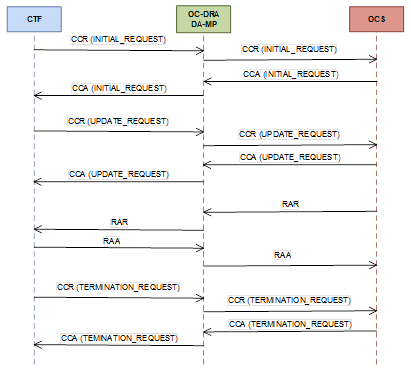Early implementations of Online Charging were based on Diameter Credit Control Application (DCCA) messages.
. The Ro reference point supports interaction between a Charging Trigger Function (CTF) and an Online Charging System (OCS). The Gy reference point is functionally equivalent to Ro, and hence is replaced by Ro within the common charging architecture. The Gy reference point is functionally equivalent to Ro, making Gy and Ro synonymous. Gy/Ro based DCCA is assigned Application-Id 4 (diameter credit-control) and used by DCCA compliant clients/servers.
- Event-Based Charging
- Session-Based Charging
Both online charging scenarios rely on Diameter Credit Control Credit-Control-Request/Answer (CCR/CCA) messages and Re-Auth-Request/Answer (RAR/RAA) messages.
Event-based charging is used for charging individual and independent events like SMS or MMS. For the event-based charging scenario, the CTF sends an OCS a Credit-Control-Request (CCR) with CC-Request-Type AVP set to EVENT_REQUEST (4).

Session-based charging is generally used for charging voice calls or data usage. For the session-based charging scenario, the session is initiated by the CTF sending an OCS a Credit-Control-Request (CCR) with CC-Request-Type AVP set to INITIAL_REQUEST (1), followed by zero, one or more CCRs with CC-Request-Type AVP set to UPDATE_REQUEST (2) until the session is terminated by the CTF sending the OCS a CCR with CC-Request-Type AVP set to TERMINATION_REQUEST (3). The OCS may also re-authorize multiple active resource quotas within a session by sending the CTF a Re-Auth-Request (RAR) message. All messages exchanged within a session use the same Session-Id value.

Charging is typically based on MSISDN and all CCRs include the MSISDN in the Subscription-Id Grouped AVP or in the User-Name AVP. In the Subscription-Id Grouped AVP, the MSISDN is typically present in the Subscription-Id-Data AVP when the corresponding Subscription-Id-Type AVP is set to "END_USER_E164". However, it is also possible that the MSISDN could be packaged in the NAI format in the User-Name AVP or in the SIP URI format in the Subscription-Id-Data AVP of the Subscription-ID grouped AVP when the corresponding Subscription-Id-Type AVP is set to "END_USER_SIP_URI".
OC-DRA attempts to retrieve the subscriber's identity from the AVPs mentioned above (in the order listed) and store them as part of subscriber state if session state is maintained. If the subscriber's identity is in the form of a SIP URI, Tel URI or a NAI format, then OC-DRA will not extract the MSISDN or perform number conditioning from these formats. Instead, itl saves the entire identity as it appears in the AVP.